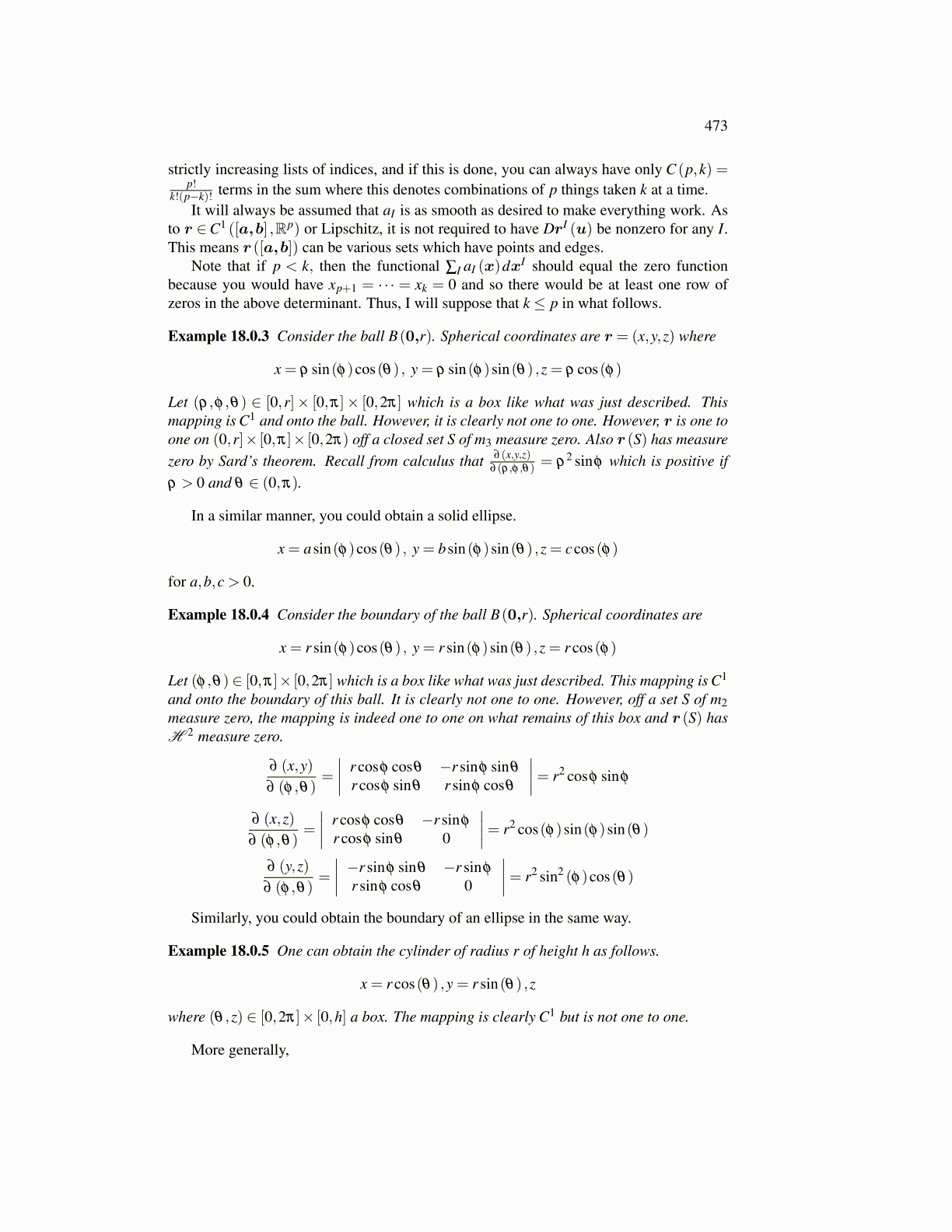
473
strictly increasing lists of indices, and if this is done, you can always have only C (p,k) =p!
k!(p−k)! terms in the sum where this denotes combinations of p things taken k at a time.It will always be assumed that aI is as smooth as desired to make everything work. As
to r ∈C1 ([a,b] ,Rp) or Lipschitz, it is not required to have DrI (u) be nonzero for any I.This means r ([a,b]) can be various sets which have points and edges.
Note that if p < k, then the functional ∑I aI (x)dxI should equal the zero functionbecause you would have xp+1 = · · · = xk = 0 and so there would be at least one row ofzeros in the above determinant. Thus, I will suppose that k ≤ p in what follows.
Example 18.0.3 Consider the ball B(0,r). Spherical coordinates are r = (x,y,z) where
x = ρ sin(φ)cos(θ) , y = ρ sin(φ)sin(θ) ,z = ρ cos(φ)
Let (ρ,φ ,θ) ∈ [0,r]× [0,π]× [0,2π] which is a box like what was just described. Thismapping is C1 and onto the ball. However, it is clearly not one to one. However, r is one toone on (0,r]× [0,π]× [0,2π) off a closed set S of m3 measure zero. Also r (S) has measurezero by Sard’s theorem. Recall from calculus that ∂ (x,y,z)
∂ (ρ,φ ,θ) = ρ2 sinφ which is positive ifρ > 0 and θ ∈ (0,π).
In a similar manner, you could obtain a solid ellipse.
x = asin(φ)cos(θ) , y = bsin(φ)sin(θ) ,z = ccos(φ)
for a,b,c > 0.
Example 18.0.4 Consider the boundary of the ball B(0,r). Spherical coordinates are
x = r sin(φ)cos(θ) , y = r sin(φ)sin(θ) ,z = r cos(φ)
Let (φ ,θ)∈ [0,π]× [0,2π] which is a box like what was just described. This mapping is C1
and onto the boundary of this ball. It is clearly not one to one. However, off a set S of m2measure zero, the mapping is indeed one to one on what remains of this box and r (S) hasH 2 measure zero.
∂ (x,y)∂ (φ ,θ)
=
∣∣∣∣ r cosφ cosθ −r sinφ sinθ
r cosφ sinθ r sinφ cosθ
∣∣∣∣= r2 cosφ sinφ
∂ (x,z)∂ (φ ,θ)
=
∣∣∣∣ r cosφ cosθ −r sinφ
r cosφ sinθ 0
∣∣∣∣= r2 cos(φ)sin(φ)sin(θ)
∂ (y,z)∂ (φ ,θ)
=
∣∣∣∣ −r sinφ sinθ −r sinφ
r sinφ cosθ 0
∣∣∣∣= r2 sin2 (φ)cos(θ)
Similarly, you could obtain the boundary of an ellipse in the same way.
Example 18.0.5 One can obtain the cylinder of radius r of height h as follows.
x = r cos(θ) ,y = r sin(θ) ,z
where (θ ,z) ∈ [0,2π]× [0,h] a box. The mapping is clearly C1 but is not one to one.
More generally,